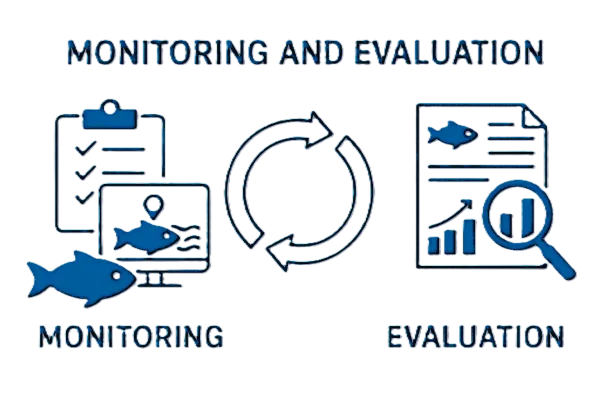Accurate, timely data is the cornerstone of effective fisheries management. Monitoring and Evaluation (M&E) is a system used to make sure everyone is playing by the rules, and to assess whether the rules are working to protect fish stocks and support sustainable use.
Monitoring involves collecting data and observing activities in the fishery to check whether rules are being followed. This includes:
Logbooks, vessel tracking (VMS), observer reports, and electronic monitoring (cameras).
Records of catch volumes (logbooks), fishing times, locations, and gear types.
Port inspections or transhipment documentation.
Evaluation is about analyzing that data to understand:
Are fishers complying with regulations?
Are the compliance measures effective?
Are there gaps in enforcement or areas where participants are struggling to comply?
Together, M&E helps detect non-compliance, understand its causes, and improve how rules are implemented and enforced.
For the WCPFC, monitoring and data collection are not just routine tasks. They form the essential foundation for decision-making and ensuring compliance with conservation measures, which is further supported through WCPFC's Compliance Monitoring Scheme.

📌The term "CCM" refers to Members, Cooperating Non-Members, and Participating Territories. Visit the "Who We Are" page to learn more about WCPFC's membership.
🔍 How does M&E Support Compliance?
1. Helps Detect Violations
- Monitoring tools like VMS and observer reports provide real-time or near-real-time visibility of fishing activity.
- This makes it easier to identify illegal activities, such as fishing in closed areas or misreporting catch.
2. Encourages Voluntary Compliance
- When fishers know their actions are being monitored, they’re more likely to comply.
- Transparency and consistency in monitoring create a level playing field, where everyone is held to the same standard.
3. Supports Risk-Based Enforcement
- Evaluation of monitoring data helps identify patterns of non-compliance, allowing enforcement agencies to focus on higher-risk vessels, fleets, or activities.
- This improves the efficiency and fairness of compliance efforts.
4. Informs Policy and Rule Improvements
- Evaluation highlights whether certain rules are unclear, overly complex, or not working in practice.
- It allows managers to adjust compliance measures to be more practical and effective.
5. Strengthens Regional and International Trust
- In regional fisheries like those managed by WCPFC, strong M&E builds confidence among members that others are upholding shared rules.
- It’s essential for cooperative management and shared stewardship of transboundary fish stocks.
Effective M&E in a compliance context is not just about catching rule-breakers. It’s about creating a system where rules are respected, enforced fairly, and continuously improved for the long-term benefit of the fishery and its participants.
Annual Report: Part 1 and 2
Members, Cooperating non-members, and Participating Territories (CCMs) are required to regularly provide a range of information to support the effective management of fisheries in the Convention Area. This includes annual submissions of statistical, biological, and other relevant data, as well as any additional data the Commission may request.
CCMs must also report on their fishing activities, including vessel operations and fishing areas, to support accurate catch and effort statistics. They are expected to inform the Commission about the steps taken to implement conservation and management measures, and to report on measures adopted at the national level for managing highly migratory fish stocks and regulating the activities of their flag vessels.
The information submitted through Part 1 and Part 2 Annual Reports is used to support scientific stock assessments as well as the annual review of compliance, which contributes to informed decision making by the Commission.
Information reported in Annual Report Part 1 is in the public domain for each CCM and can be found in the meeting documents of the Scientific Committee.
Information reported in Annual Report Part 2 is classified as non-public domain data and is only accessible by authorised CCM users through their Member credentials in the Secure Portal.
Explore Further
- Annual Report Part 1 Template
- Scientific Committee meeting webpage to view CCM Annual Report Part 1
Technical and Compliance Committee
The Technical and Compliance Committee (TCC) is established by the WCPF Convention as one of the Commission's subsidiary bodies to provide it with advice and recommendations on matters relating to the implementation of, and compliance with, conservation and management measures.
The TCC supports the WCPFC by carrying out assessments on how well Members are implementing and complying with the Commission’s rules. It monitors compliance with conservation and management measures, reviews enforcement actions, and evaluates cooperative monitoring, control, and surveillance (MCS) efforts. Importantly, the TCC reviews the Commission's data requirements, ensuring that it has the best available scientific and other information on which to base its decisions.
The TCC also serves as a forum for Members to exchange information on national implementation, receive reports on violations, recommend observer programme priorities, and advise on technical matters like fishing gear and data validation. A key function of the TCC is to review the Commission's annual draft compliance monitoring report that assesses how well CCMs are performing against their obligations.
TCC's work helps ensure that WCPFC decisions are effectively carried out and backed by reliable oversight and data across the region.